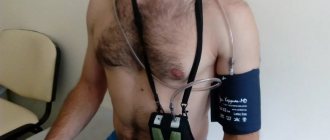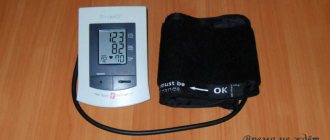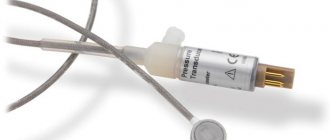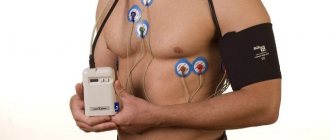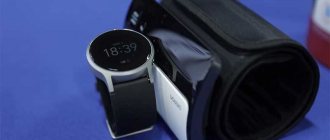In the modern world, filled with endless bustle, obligations, work and other matters of high importance, you need to be able to stop in time and ask yourself the only question: is everything okay with my health? The human heart, unfortunately, has a very limited resource. And all other functions of the body depend on how well it works. Therefore, monitoring blood pressure, one of the most important parameters characterizing the functioning of the circulatory system, is the first necessity of every person who takes care of himself and thinks about his loved ones.
What is a daily ECG or why watch a cardiogram all day long?
Patients often complain of interruptions in heart function and arrhythmia. And sometimes for pain in the heart area or behind the sternum during physical exertion. However, at the doctor’s appointment, as luck would have it, nothing worries him, and the doctor just shrugs, looking at the “ideal” ECG. Fortunately, the American Norman Holter came up with a brilliant idea many years ago - why not record an ECG in various life situations, for example, when you are worried, running after a bus, watching a melodrama, or just sleeping. This will help detect changes that are inaccessible to conventional outpatient examination. First of all, suspicion of arrhythmia . Under an overly general definition, there are about 50 different cardiac arrhythmias, some of which can manifest themselves only at night, some - exclusively during exercise, and to diagnose some arrhythmias (for example, unscheduled heartbeats - atrial or ventricular extrasystoles), it is important to calculate their total quantity per day. In this case, the doctor receives not just dry statistics in the form of a cardiogram, he can compare the ECG data with the patient’s diary - whether the appearance of arrhythmia is accompanied by specific complaints. Another pathology that can be detected using daily monitoring is coronary heart disease . Finding ischemia on an ECG means proving that the cause of pain is precisely atherosclerotic damage to the vessels of the heart, and not something else. The evidence will be especially strong if ischemic changes on the cardiogram are accompanied by pressing pain in the chest, an indication of which is present in the patient’s diary.
How does a holter work?
The monitoring device is a portable device with a memory card, to which several electrodes are connected using wires, transmitting the heart rhythm in the form of an ECG. The information is read by the device and recorded on the memory card. At the end of the study, the equipment is handed over to the doctor, who interprets the results and identifies possible violations.
There are two types of holters:
- Three-channel (simple) – records shocks and electrical activity;
- Twelve-channel (complex) – additionally analyzes the level of oxygen supplied to the muscle.
Unlike a conventional ECG, this type of examination makes it possible to continuously record heart rhythms in various life situations for a long time. During monitoring, more than 100 thousand contractions are recorded, whereas during a regular cardiogram - only 50-60.
During an electrocardiogram, it is not always possible to identify pathologies, since failures are often provoked by external factors: increased physical activity, emotional fluctuations, etc.
Fragmentary recording is allowed - when the inclusion of the cardiac recorder is controlled by the patient. That is, the equipment is recorded for a day or more, but recording is carried out only after switching on, if a person feels pain, signs of arrhythmia or other symptoms. There are devices for fragmented monitoring in the form of a bracelet that is attached to the wrist.
What are the main signs of myocardial ischemia during Holter monitoring?
The main symptom is depression (subsidence downward from the isoline) of the ST segment by 2 mm or more. If such a change in the cardiogram appears against the background of physical activity and is accompanied by pressing pain in the chest, this can be considered indisputable evidence of ischemia (lack of blood for the myocardium) and the patient can be sent for coronary angiography. There are also indirect signs of ischemia that require the attention of a doctor, for example, the appearance of unscheduled heart contractions - extrasystoles - or blockade of the left bundle branch against the background of a load.
What does a Holter ECG show?
The purpose of the study is to reflect the work of the heart during wakefulness and sleep, so that the information obtained makes it possible to assess the nature and number of muscle contractions over the entire observation period. Any deviations from the norm will not go unnoticed.
Based on the results, the doctor can identify the following pathologies:
- angina pectoris;
- arrhythmia:
- hypertension;
- IBS.
It is also possible to detect ischemia at an early stage, including before the appearance of clinical signs.
How to determine whether it is time to install a pacemaker?
Another task of daily ECG monitoring is to detect dangerous “pauses” between heartbeats that threaten sudden cardiac arrest. As a rule, pauses rarely occur during the day, so it is almost impossible to detect them on a regular cardiogram. But at night they can walk one after another; pauses lasting more than 3 seconds are especially dangerous. Another dangerous symptom is a decrease in heart rate less than 45 Bpm. After analyzing the daily ECG, the doctor will be able to decide on installing a pacemaker that will maintain a normal frequency and prevent dangerous pauses from occurring.
Decoding the results
To decrypt the data, the Holter is connected to a computer, after which a specialist analyzes it. The list of observation results includes the following indicators:
- the total time of fixation of contractions, indication of the frequency of beats;
- conduction disturbance (blockade);
- pauses in activity;
- rhythmic disruptions;
- assessment of the dynamics of individual ECG segments;
- other information important for making a diagnosis.
Monitoring allows you to identify any deviations in the functioning of the cardiovascular system and prescribe adequate therapy to restore its normal activity.
Can Holter measure blood pressure?
24-hour heart rate monitoring can be supplemented by blood pressure . It is quite simple to spot a person with such a device in a crowd - he stops abruptly and freezes for a minute. What can you do, because the doctor forbade you to move when the cuff is inflated and the measurement begins. As a result of its measurements, the device generates a report on daily fluctuations in blood pressure, determines daytime and nighttime peaks, and by analyzing the patient’s diary, it is possible to determine what causes the rise in pressure. Another indication for monitoring blood pressure is to monitor the effectiveness of treatment for hypertension.
How is the monitoring procedure carried out?
Equipment installation is carried out in the clinic and includes the following manipulations:
- electrodes are installed on the bare torso, pre-treated with an alcohol solution, according to a certain pattern (for reliable fixation they can be glued with an adhesive plaster);
- The halter is placed in a special bag-pocket on the belt and connected to sensors;
- if necessary, an additional cuff is installed to control blood pressure.
Wearing the device does not restrict movement and does not interfere with leading a normal lifestyle. You can work, study, do fitness and any other usual activities.
In order for the study to be more informative and the doctor to be able to analyze the effect of psychological and physical stress on the heart, the patient must describe all his actions in a special diary from the start of installation until the cardiac recorder is turned off.
The patient’s activities are entered into the diary, indicating the time of change of activities:
- taking food and medications;
- active activities;
- mood changes;
- periods of sleep.
In addition to describing the actions, records should be accompanied by comments about sensations: manifestations of shortness of breath, pain and other unpleasant symptoms.
What should be reflected in the diary:
- rest, including minimal activity: drawing, reading, watching TV.
- emotional and mental activities: study, work (not requiring much effort), driving, communication;
- light physical activity: leisurely walk;
- medium: climbing stairs, jogging;
- heavy: fast running, strength training.
The information content of the observations depends on how detailed each action is described. Sometimes your doctor will ask you to do exercises to evaluate your heart's response to physical activity and how quickly it recovers to normal levels.
At the end of the study, the sensors and device are removed by a healthcare professional. You should not clean the device yourself.
Why does the doctor suggest re-hanging the device after some time?
Holter monitoring is simply an irreplaceable method when it comes to monitoring the treatment of arrhythmia and ischemia , and assessing its effectiveness. Typically, the cardiologist prescribes a repeat study no earlier than a month after the start of therapy. If the number of episodes of arrhythmia has decreased, the blood supply to the myocardium has improved - the doctor has guessed the treatment, if not, it is possible to change the drugs or their dosage. And after some time, repeat the study. What to do, treatment of arrhythmia requires a scrupulous approach.
Is it possible to deceive Holter?
First of all, you should think about the appropriateness of distorting information. After all, it is realistic indicators that will allow you to most accurately assess the work of the heart, analyze possible risks and determine the presence of pathology. Of course, a person can influence the frequency of contractions by changing the level of activity (if it is necessary to lower the frequency, then rest is needed during monitoring, and if it is necessary to increase the heart rate, heavy exercise will help).
In addition, the functions of the heart muscle are affected by:
- lack of sleep and rest;
- drinking energy drinks;
- taking medications;
- caffeine abuse, etc.
You must remember that your health depends on a correct diagnosis and the effectiveness of treatment. It will not be possible to hide serious disorders, including arrhythmia, even while taking antihypertensive medications.
If the doctor suspects intentional distortion of the data obtained, the patient is sent to the hospital to undergo additional examination under the supervision of medical workers.
How to prepare for research?
No special preparation is required, but, if possible, the doctor will temporarily stop taking some medications or reduce their dosage in order to conduct as “clean” a study as possible. Men with rich chest hair will have to work with a razor, otherwise it will be difficult to attach the electrodes.
Today, 24-hour ECG monitoring is a routine research method that provides an invaluable service to the therapist or cardiologist. According to experts, more than half of cardiac diagnoses are “born” from Holter. The main thing is that the study is carried out correctly, and the patient not only does not constrain himself in vital activity during monitoring, but, on the contrary, gives himself an increased load, as if checking the operation of his own engine at high speeds.
If you still have questions, you can ask your cardiologist online in the Doctis application.
Holter studies - what is it?
The essence of diagnosis is the continuous recording of heartbeat rhythms. To do this, electrode sensors are fixed on the patient's chest, transmitting the converted information to a cardiac recorder (holter) - a small device for recording an ECG that can be worn on a belt. Thus, a person may not change his usual way of life when a portable ECG device conducts constant cardiac monitoring. As a rule, observation is carried out within 24 hours, but if there are indications, the procedure can be prescribed for up to 7 days.
The weight of the equipment usually does not exceed 500 g, so it does not require changes in the usual daily routine. The examination is possible for both adults and children.
When is the procedure contraindicated?
24-hour blood pressure monitoring has no absolute clinical contraindications. The examination may be temporarily postponed for the following reasons:
- skin rashes;
- period of exacerbation of dermatological diseases occurring in a chronic form;
- fractures;
- burn lesions;
- bruises, traumatic injuries.
Various injuries and violations of the integrity of the skin in the area where the cuff is installed make the examination impossible. In such cases, diagnosis is postponed until the patient’s skin has fully recovered and restored.
In case of a fracture, ABPM is not possible
What to avoid during Holter diagnostics
The use of a holter has its own characteristics. The Holter ECG result can be disrupted by a number of devices. This will make the results incorrect and undo all the work.
- You must not use the microwave oven or even approach it while it is operating.
- Devices that transmit radio signals cannot be used; mobile phones can be used without restrictions
- You should avoid the metal detector frame; it is not even recommended to walk near it
- You cannot pass through the electromagnetic arches that the stores are equipped with. It is better to avoid shopping altogether on the day of diagnosis.
- You cannot go through other diagnostic options using x-rays, ultrasound, magnetic waves
- Do not remove batteries from the recorder, expose it to intense heat, or get it wet.
Holter: monitoring and analysis of heart function
A holter is attached to the patient, most often on a belt, in a special case and electrodes are applied. Doctors often use the phrase “hang up the Holter” or “make a Holter”, meaning that the device will be used for 24 hours, on an outpatient basis, in the patient’s usual living conditions - at home, at work, during night sleep. Patients are asked not to wet the device, but otherwise lead their usual lifestyle.
This process of taking readings is called Holter monitoring, named after the American research scientist Norman J. Holter, who first used this technique in 1961.
It's easy to go through the research.
It is easy to undergo a study at the Poema Health clinic. It is located near Ozerki metro station and Prosveshcheniya metro station, the halter is installed quickly and at a time convenient for you. The best version of the device will be selected, instructions will be provided and the device will be installed. Upon completion of the study, you will return to us, and the doctor will decipher the data from the Holter and, comparing it with your diary, will make a diagnosis. After this, you can decide on treatment and be firmly on the path to recovery.
Have questions? Call: +7(812) 30-888-03.
Holter examination will not cause any inconvenience
If you need a Holter ECG, but you are afraid of the procedure itself, then you just need to understand the rules for its implementation. The doctor will place electrodes on your body, mainly on the bones of the chest with minimal muscle coverage. The natural movement of muscles during movement and breathing can reduce the accuracy of data recording. The electrodes do not generate electric shock and do not produce any effect on your body at all. After installing the electrodes, the recorder is turned on and the study begins. That's all it takes.
